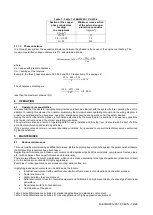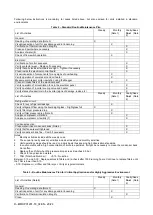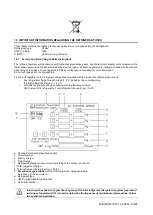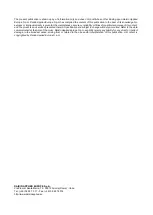
D
–EIMHP01201-18_04EN - 17/24
3.8
Evaporator and condenser exchangers anti-freeze protection
Evaporator and condenser are supplied with a thermostatically controlled anti-freeze electrical resistance, which provides
adequate anti-freeze protection at temperatures as low as
–16°C.
However, unless the heat exchangers are completely empty and cleaned with anti-freeze solution, additional methods
must also be used against freezing.
Two or more of below protection methods shall be considered when designing the system as a whole:
−
Continuous water flow circulation inside piping and exchangers
−
Addition of an appropriate amount of glycol inside the water circuit
−
Additional heat insulation and heating of exposed piping
−
Emptying and cleaning of the heat exchanger during the winter season
It is the responsibility of the installer and/or of local maintenance personnel to ensure that described anti-freeze methods
are used. Make sure that appropriate anti-freeze protection is maintained at all times. Failing to follow the instructions
above could result in unit damage. Damage caused by freezing is not covered by the warranty.
3.9
Installing the flow switch
To ensure sufficient water flow through the evaporator and condenser, it is essential that a flow switch be installed on both
water circuits. The flow switch can be installed either on the inlet or outlet water piping. The purpose of the flow switch is
to stop the unit in the event of interrupted water flow, thus protecting the evaporator and the condenser.
The manufacturer offers, as optional, a flow switch that has been selected for this purpose.
This paddle-type flow switch is suitable for heavy-
duty outdoor applications (IP67) and pipe diameters in the range of 1” to
8
”.
The flow switch is provided with a clean contact which must be electrically connected to terminals shown in the wiring
diagram. Flow switch has to be tune to intervene when the evaporator and/or condenser water flow is lower than 50% of
nominal flow rate.
For a proper unit operation, the water flow-rate of both heat exchangers (evaporator and condenser) must always
recirculate when the unit switch is active (On).
Fig. 7 - Water piping connection
1. Pressure Gauge
2. Flexible connector
3. Flow switch
4. Temperature probe
5. Isolation Valve
6. Pump
7. Filter
3.10
Minimum system water volume (for Cold and Hot side)
All cold and hot water systems need adequate time to react to a load change. In case of multipurpose unit, the machine
follows the set-point on cold side as well as the se-point on hot side. The control of the heating and cooling capacity of
the unit is achieved by managing the load of the compressors (with VFD) and by cycling each circuit independently
between the following operating modes: cooling only, c heating, and heating only. The potential for short cycling
usually exists when the cooling an
d heating loads falls below the minimum unit’s capacity or in systems with insufficient
water volumes.
Design considerations for systems water volume are the minimum cooling and heating load; the minimum cooling and
heating unit’s capacity; the time for each circuit to perform the switch of operating mode; on heating side also the defrost
effects needs to be considered.
The water content is necessary to ensure the stability of plant operation and accurate temperature control. To determine
the right value all the component of the systems should be considered as well as the plant layout and control strategy in
place.
Assuming that there are no sudden load changes and that the chiller plant has reasonable turndown, a rule of thumb of
“6,5 litres per kW” is considered for comfort cooling and comfort heating application. The water content is calculated on
the bases of the “6.5 lt/kW” rule, is intended as the useful water volume always flowing through both cold and hot heat
exchangers.
Note that in presence of any bypass that cause short circuit of the supply water with the return the resulting useful
volume will be lower and lead to system instability.






















